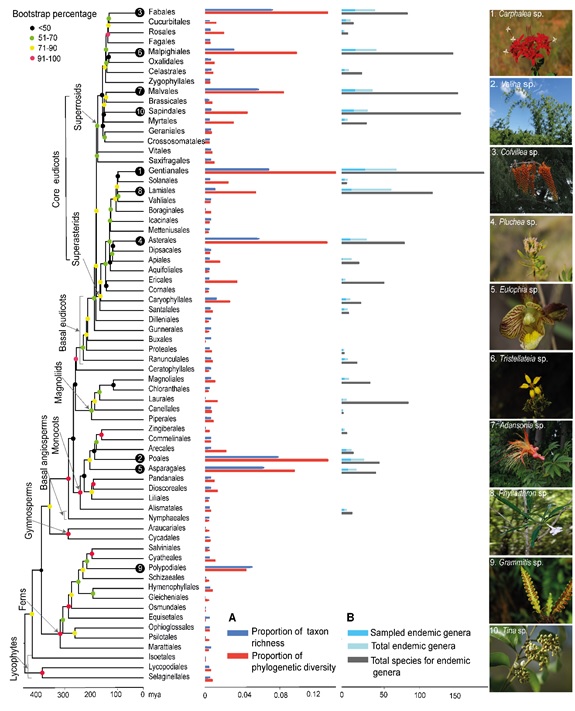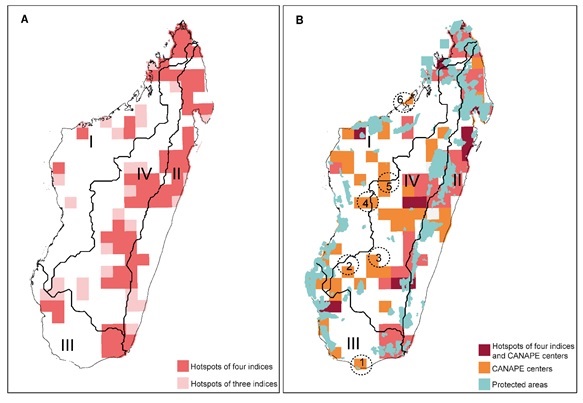Despite the importance of biodiversity and the urgence to conserve it, the assessment of which portion of it requires the highest priority has proved complex, especially when resources for conservation are limited. A new study published in Current Biology has shed light on this question.
Prof. CHEN Zhiduan’s team from the Institute of Botany of the Chinese Academy of Sciences (IBCAS) and international collaborators identified spatial heterogeneity of biodiversity hotspots and endemism centers and detected conservation priority for vascular plants in Madagascar.
Madagascar is the fourth largest island in the world, which is one of the foremost global biodiversity hotspots and is well known for its high level of endemic diversity. This high level of endemism has been largely attributed to its complex geological history, geographic location, and biogeographic connections with Africa, India, southeast Asia, and northern Australia.
The researchers generated a novel dated tree of life for the island, which included unprecedented sampling of 3950 species (33% of total known species) and 1621 genera (93% of total known genera) of Malagasy vascular plants. They found that most of the extant endemic genera (69%) in Madagascar originated relatively recently during the Neogene-Quaternary.
Integrating phylogenetic and geographic distribution data, the researchers revealed an uneven distribution of taxon richness and phylogenetic diversity, with hotspots concentrated in the northern, eastern, and southeastern humid forests. They further evaluated endemic centers incorporating both taxonomic endemism and phylogenetic endemism, which consistently supported high concentration of paleo-endemism in the humid eastern and central regions, whereas neo-endemism in the dry and spiny forests in western and southern Madagascar.
Finally, the study identified conservation gaps in the often-ignored arid and semi-arid regions by overlaying diversity hotspots and centers of endemism with protected areas. These conservation gaps provide additional evidence to support the preservation of multiple facets of biodiversity in Madagascar in the face of climate change and increased anthropogenic pressures.
This work was supported by the National Natural Science Foundation of China, the International Partnership Program of Chinese Academy of Sciences, Sino-Africa Joint Research Center, Chinese Academy of Sciences, the Chinese Academy of Sciences International Research and Education Development Program, the Youth Innovation Promotion Association of CAS, etc.

A summarized order-level chronogram of Malagasy vascular plants, highlighting taxon richness and phylogenetic diversity in each order. (Image by IBCAS)

Diversity hotspots, centers of phylogenetic endemism, and conservation gaps for Malagasy vascular plants. (Image by IBCAS)
Article Link: https://doi.org/10.1016/j.cub.2024.02.023
Contact:
Prof. LU Limin,liminlu@ibcas.ac.cn
The Institute of Botany, Chinese Academy of Sciences
Despite the importance of biodiversity and the urgence to conserve it, the assessment of which portion of it requires the highest priority has proved complex, especially when resources for conservation are limited. A new study published in Current Biology has shed light on this question.
Prof. CHEN Zhiduan’s team from the Institute of Botany of the Chinese Academy of Sciences (IBCAS) and international collaborators identified spatial heterogeneity of biodiversity hotspots and endemism centers and detected conservation priority for vascular plants in Madagascar.
Madagascar is the fourth largest island in the world, which is one of the foremost global biodiversity hotspots and is well known for its high level of endemic diversity. This high level of endemism has been largely attributed to its complex geological history, geographic location, and biogeographic connections with Africa, India, southeast Asia, and northern Australia.
The researchers generated a novel dated tree of life for the island, which included unprecedented sampling of 3950 species (33% of total known species) and 1621 genera (93% of total known genera) of Malagasy vascular plants. They found that most of the extant endemic genera (69%) in Madagascar originated relatively recently during the Neogene-Quaternary.
Integrating phylogenetic and geographic distribution data, the researchers revealed an uneven distribution of taxon richness and phylogenetic diversity, with hotspots concentrated in the northern, eastern, and southeastern humid forests. They further evaluated endemic centers incorporating both taxonomic endemism and phylogenetic endemism, which consistently supported high concentration of paleo-endemism in the humid eastern and central regions, whereas neo-endemism in the dry and spiny forests in western and southern Madagascar.
Finally, the study identified conservation gaps in the often-ignored arid and semi-arid regions by overlaying diversity hotspots and centers of endemism with protected areas. These conservation gaps provide additional evidence to support the preservation of multiple facets of biodiversity in Madagascar in the face of climate change and increased anthropogenic pressures.
This work was supported by the National Natural Science Foundation of China, the International Partnership Program of Chinese Academy of Sciences, Sino-Africa Joint Research Center, Chinese Academy of Sciences, the Chinese Academy of Sciences International Research and Education Development Program, the Youth Innovation Promotion Association of CAS, etc.

A summarized order-level chronogram of Malagasy vascular plants, highlighting taxon richness and phylogenetic diversity in each order. (Image by IBCAS)
Diversity hotspots, centers of phylogenetic endemism, and conservation gaps for Malagasy vascular plants. (Image by IBCAS)
Article Link: https://doi.org/10.1016/j.cub.2024.02.023
Contact:
Prof. LU Limin,liminlu@ibcas.ac.cn
The Institute of Botany, Chinese Academy of Sciences
